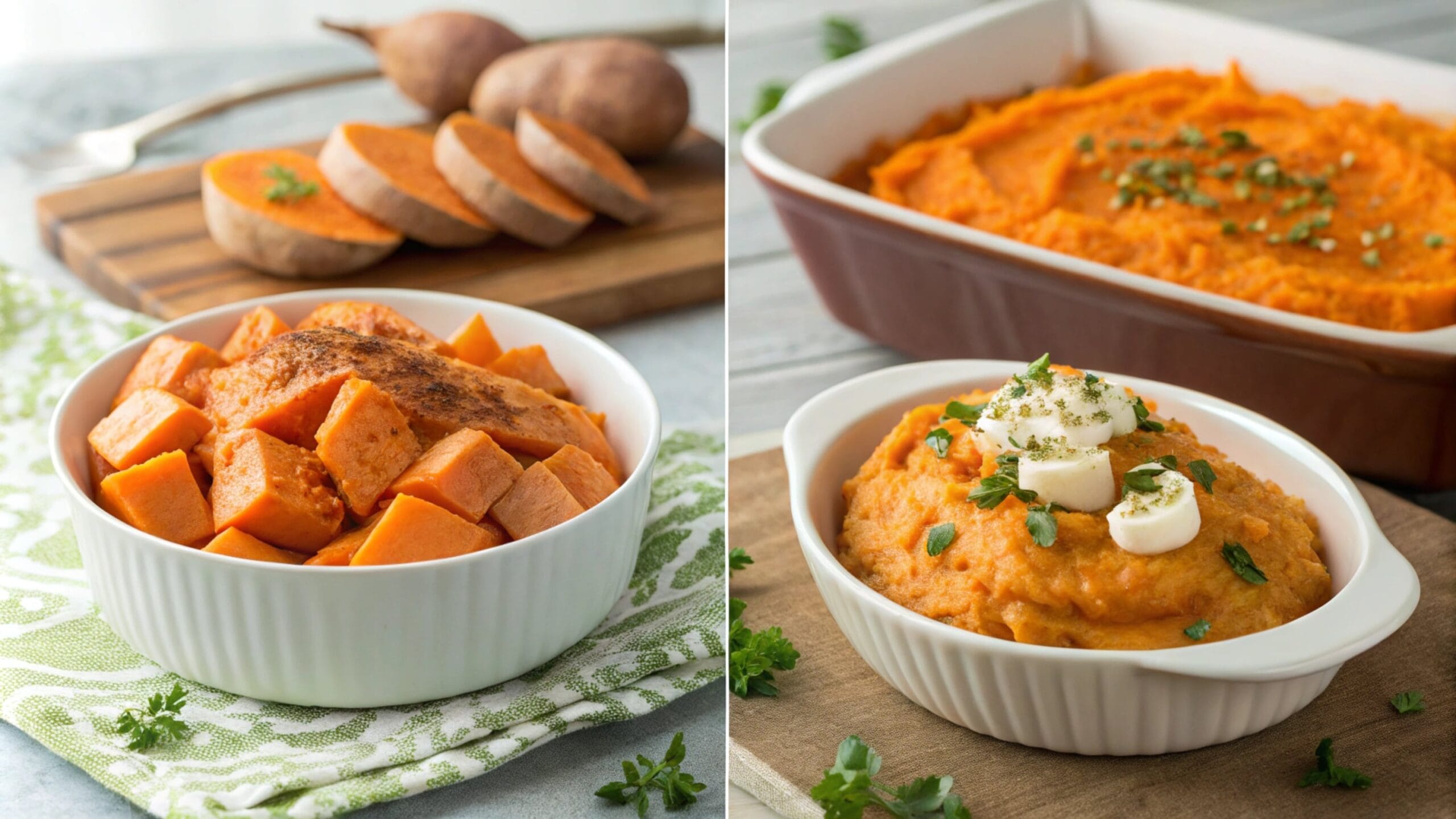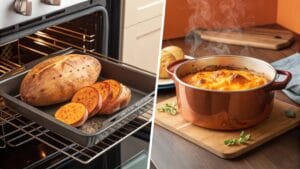Bake or Boil Sweet Potatoes: Which Is Best for Casseroles?
Sweet potato casserole is a classic dish often served at holidays and family gatherings. Known for its creamy texture, rich flavor, and comforting sweetness, it’s a favorite addition to any table. However, a key factor in making the perfect casserole lies in how you prepare the sweet potatoes: should you bake or boil sweet potatoes?
This choice influences not only the flavor but also the texture and nutritional content of the dish. Baking sweet potatoes caramelizes their natural sugars, enhancing sweetness, while boiling offers a quicker, moist base for mashing. Both methods have their advantages, but understanding their differences will help you decide whether to bake or boil sweet potatoes for your next casserole.
Understanding Sweet Potatoes for Casseroles
Sweet potatoes are not just a versatile ingredient—they’re a nutrient-rich staple enjoyed in cuisines worldwide. Whether featured in casseroles or desserts, they shine in a variety of dishes due to their natural sweetness and adaptability. Knowing their characteristics, types, and benefits will help you decide how best to bake or boil sweet potatoes for your recipes.
What Are Sweet Potatoes?
Sweet potatoes are starchy root vegetables celebrated for their bright orange flesh and naturally sweet flavor. Originally from Central and South America, they’ve gained worldwide popularity for their affordability, rich taste, and flexibility in the kitchen. Whether you choose to bake or boil sweet potatoes, they remain a key ingredient for countless dishes.
Nutritional Profile
Sweet potatoes are packed with nutrients, making them an excellent choice for health-conscious cooks:
- Beta-carotene: Converts to vitamin A in the body, supporting eye health and immunity.
- Dietary Fiber: Promotes digestive health and helps maintain steady blood sugar levels.
- Vitamin C: Boosts immunity and skin health.
- Potassium: Supports muscle function and heart health.
- Antioxidants: Help combat oxidative stress and inflammation.
Check out How Do You Make Martha Stewart’s Sweet Potato Casserole?
Different Varieties of Sweet Potatoes for Casseroles
Sweet potatoes come in a range of varieties, each with unique characteristics suited for different recipes:
- Orange-Fleshed Sweet Potatoes: The most common type, known for its sweetness and creaminess, is ideal for casseroles.
- White-Fleshed Sweet Potatoes: Milder in flavor and starchier, suitable for savory dishes.
- Purple Sweet Potatoes: Rich in antioxidants, these have a denser texture and slightly nutty flavor.
- Japanese Sweet Potatoes: Sweet and starchy, often used in desserts and baking.
Sweet Potatoes vs. Yams for Casseroles
While sweet potatoes are often mistakenly called yams, they are distinct from true yams, which have rough, scaly skin and are less sweet. Sweet potatoes are softer, sweeter, and more versatile in cooking, making them perfect for casseroles.
Cooking Applications for Sweet Potatoes in Casseroles
Sweet potatoes shine in a variety of dishes, from baked goods to savory casseroles:
- Baked: Retains natural sweetness and creates a caramelized exterior.
- Boiled: Softens the texture for mashing or pureeing.
- Roasted: Enhances the flavor with a slightly crispy exterior.
- Fried: Perfect for sweet potato fries or chips.
- Steamed: Preserves nutrients while softening the flesh.
Why Sweet Potatoes Are Perfect for Casseroles
Sweet potatoes are ideal for casseroles due to their:
- Creamy Texture: When cooked, they mash easily, creating a smooth base.
- Natural Sweetness: Pairs well with both savory and sweet toppings.
- Nutritional Benefits: Adds a healthy twist to comfort food favorites.
By understanding sweet potatoes for casseroles, you can unlock their full potential, creating dishes that are as nutritious as they are delicious. Whether you choose to bake, boil, or roast them, sweet potatoes remain a versatile and essential ingredient in your kitchen.
If you’re looking for inspiration, check out How Do You Make Martha Stewart’s Sweet Potato Casserole? for tips on crafting a perfect casserole.
Baking Sweet Potatoes for Casseroles
Baking sweet potatoes is a popular method for preparing them for casseroles, especially when you want to highlight their natural sweetness and achieve a rich, dense texture. This method brings out the best in sweet potatoes by caramelizing their natural sugars and locking in their flavor, making it an excellent choice for casseroles that aim to be indulgent and hearty.
Step-by-Step Baking Instructions
- Preheat the Oven: Set your oven to 375°F (190°C) and allow it to fully preheat for even cooking.
- Prepare the Sweet Potatoes: Rinse the sweet potatoes thoroughly under running water to eliminate any dirt or debris. Dry them with a clean towel. If you prefer, leave the skins on for added texture or nutrients.
- Pierce the Skins: Use a fork to poke several holes into the sweet potatoes. This step allows steam to escape and prevents them from bursting during baking.
- Place on a Baking Tray: Arrange the sweet potatoes on a baking sheet lined with foil or parchment paper to catch any drips.
- Bake: Bake the sweet potatoes for 45–60 minutes, depending on their size. Check doneness by inserting a fork; it should glide in effortlessly.
- Cool and Peel: Let the sweet potatoes cool slightly before peeling (if desired). The skins should come off easily after baking.
Advantages of Baking Sweet Potatoes
- Enhanced Flavor: Baking caramelizes the natural sugars in sweet potatoes, intensifying their sweetness and creating a rich flavor profile.
- Nutrient Retention: Unlike boiling, baking doesn’t leach nutrients into water, helping to retain more vitamins and minerals.
- Perfect for Casseroles: Baked sweet potatoes have a dense texture that pairs well with casseroles requiring a hearty base or layers.
Disadvantages of Baking Sweet Potatoes
- Longer Cooking Time: Baking takes 45–60 minutes, which may not be ideal for time-sensitive preparations.
- Requires Oven Space: If your oven is already in use, baking sweet potatoes may be inconvenient during busy cooking times.
- Not Ideal for All Recipes: The dense texture might not be suitable for lighter, fluffier casserole styles.
When to Choose Baking for Casseroles
- Sweet Casseroles: Recipes that highlight sweetness, such as those with marshmallow or brown sugar toppings, benefit from the enhanced flavor of baked sweet potatoes.
- Dense Textures: Casseroles that rely on a thick, structured base work best with the firmer texture of baked sweet potatoes.
- Special Occasions: Baking is ideal for times when you can plan ahead, allowing the flavors and textures to shine in a finished dish.
Baking sweet potatoes is an excellent choice for casseroles that aim to deliver bold flavors and a luxurious texture. While it may require more time, the depth of flavor and nutrient preservation make it a method worth considering for your next culinary creation.
Check out Old-Fashioned Sweet Potato Casserole for a classic preparation.



3 thoughts on “Is it Better to Bake or Boil Sweet Potatoes for Casserole?”